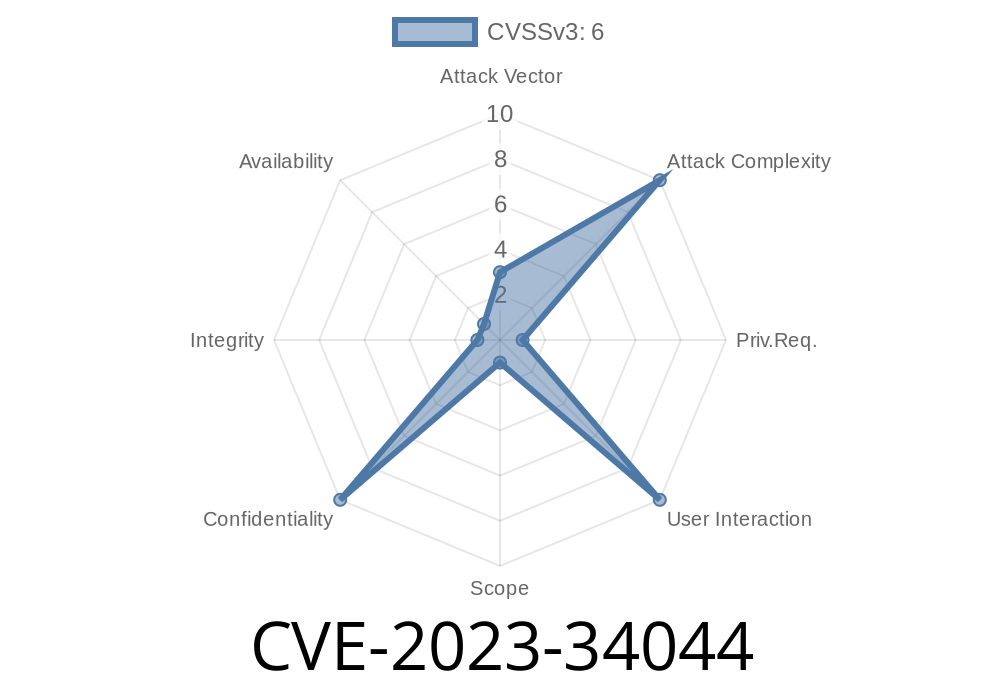CVE-2023-34044 is a vulnerability found in VMware Workstation and VMware Fusion, specifically in versions before Workstation 17.5 and Fusion 13.5. This bug exists in the Bluetooth device sharing feature. When a host shares its Bluetooth devices with a virtual machine (VM), a weak spot appears in the Bluetooth code, opening the door to an out-of-bounds read bug. This can let someone in a VM read sensitive data from the hypervisor memory, which should have been off-limits.
Affected products and versions
- VMware Workstation: 17.x before 17.5 (download page)
- VMware Fusion: 13.x before 13.5 (download page)
Official advisory:
VMware Security Advisory VMSA-2023-0016
Why Is This Important?
- The attack requires local administrative rights on a VM. That means it's not exploitable remotely or from a guest user account—you need admin on the guest system.
- With this access, a hacker can steal sensitive information from the host, including process memory, encryption keys, or anything else that could be stored in the hypervisor.
- Anything leaking from the hypervisor is a big deal, especially in shared hosting situations or on developer machines.
How Does The Vulnerability Work?
Bluetooth device sharing uses a custom protocol to connect the host’s Bluetooth hardware with the guest VM. The vulnerability is the result of the VM handling buffer boundaries incorrectly when processing certain Bluetooth messages.
Guest code sends specially crafted Bluetooth packets to the Bluetooth interface.
2. The affected VMware code (running on the host in the hypervisor) reads data past the end of the intended buffer—an out-of-bounds read.
3. The guest can fish out slices of adjacent memory, which may contain confidential data from the hypervisor or host.
Technical Details (Simplified)
The vulnerability lies in the function where the VMware Bluetooth emulation parses incoming packets from the guest.
If the guest sends a packet with a length field that tricks the handler, the handler reads beyond the intended buffer (out-of-bounds) and returns those extra bytes back to the guest. This reveals memory that’s not meant to be exposed.
Let’s look at some example pseudo-code to understand the concept
void handle_bluetooth_packet(char* buf, int length) {
char internal_buffer[64];
// Incorrect bounds checking!
memcpy(internal_buffer, buf, length);
// ... processing ...
}
If length is larger than 64, it'll copy data past the internal_buffer—out-of-bounds!. In VMware’s Bluetooth device sharing, this flawed logic lets the guest VM see host memory.
Demonstration Exploit (Hypothetical Snippet)
Here's a simplified Python code snippet showing how a guest VM attacker might craft and send a malicious packet to trigger the bug (Note: Does not actually exploit the real bug, for educational use only):
import socket
def send_malicious_bluetooth_packet():
# Example: Connect to VMware's Bluetooth service inside the VM
s = socket.socket(socket.AF_BLUETOOTH, socket.SOCK_SEQPACKET, socket.BTPROTO_L2CAP)
s.connect(("00:1A:7D:DA:71:13", 1)) # Replace with actual address & port
# Craft a packet with a wrong length field
payload = b"A" * 128 # 128 > expected buffer size
s.send(payload)
leaked = s.recv(256)
print("Leaked data:", leaked)
send_malicious_bluetooth_packet()
Warning: This is not a real exploit. Actual exploitation would require understanding of VMware’s Bluetooth internals and may use device passthrough features rather than raw sockets.
Real World Risks
- If an attacker already controls a VM (as admin), they can escape the isolation and read data from the host.
- On shared environments or CI/CD pipelines, this could let a guest steal other customers' or host secrets.
How To Protect Yourself
- Update VMware Workstation and Fusion to at least Workstation 17.5 and Fusion 13.5. See VMware’s downloads.
References and Further Reading
- Official CVE page
- VMware Security Advisory VMSA-2023-0016
- Mitre description
Conclusion
CVE-2023-34044 reminds us that device sharing features in virtual machines can open the door to complex bugs like out-of-bounds reads. Even if exploitation requires admin access on a VM, if your business or development setup uses VMware, this is a high priority patch.
Update your software and disable Bluetooth sharing!
Stay safe and keep your hypervisor secure.
*This guide is exclusive to you and written in plain language to help you understand vulnerabilities that could affect your virtual environments. If you found it helpful, consider sharing with your team!*
Timeline
Published on: 10/20/2023 09:15:12 UTC
Last modified on: 10/28/2023 03:34:06 UTC
